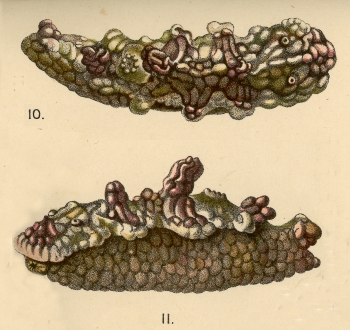
Ceratosoma magnificum
(Eliot, 1910)
Order: NUDIBRANCHIA
Suborder: DORIDINA
Superfamily: EUDORIDOIDEA
Family: Chromodorididae
DISTRIBUTION
Western Indian Ocean?
PHOTO
Miamira magnifica: original illustrations from Eliot, 1910: Pl. 25.
Note added 4 July 2007: The name is changed today from C. magnifica to C. magnificum - see message #20101.
Until now I have, like Baba & Hamatani (1974), considered all the various coloured forms of 'Miamira' to be part of one variable species of Ceratosoma, C. sinuatum [see message #19853] but the persistent use of the name 'Miamira magnifica' and 'Ceratosoma magnifica' in colour picture books has caused widespread confusion.
While it has been possible to identify C. sinuatum and C. flavicostatum from their original descriptions, the original description of C. magnificum is so lacking in detail of the living animal that it is very difficult to be sure just what the name represents [see message #19854 ].
Like so many early descriptions, it was based on a single preserved specimen from the Seychelles, and as Eliot notes 'this description was taken from the preserved animal some time after the colour drawing was made'. In this description he mentions greens and purples and white spots, but we have no idea whether these colours represent the live animal or are the result of the pigments reacting to preservatives. If the greens are real colours then C. magnificum might be the same as C. sinuatum because C. flavicostatum does not have green coloration, but from the original drawings we can see that the mantle has a pattern of rounded tubercles and some short ridges. Eliot does note that the oral tube is a 'beautiful purple colour' and the rachis of the gills is a yellowish white, making 'a vivid contrast of colours' which may suggest C. flavicostatum, but we can't be sure.
Is is possible that Eliot's M. magnificum is a third species. At present we have no record of a living 'flavicostatum'- like animal from the western Indian Ocean, where M. magnificum was found. However there are three records on the Forum of 'sinuatum'-like animals with yellow lines on the rhinophore clubs, one from South Africa [#2147] with white edged gills and two from the Red Sea [#13210, #6822], with red edged gills. Perhaps this is Eliot's species? At present I am recognising C. sinuatum and C. flavicostatum, because they are identifiable, and tentatively recognising C. magnificum for the few anomolous western Indian Ocean animals I mention above.
-
Baba, K. (1940) Miamira flavicostata n.sp., a nudibranchiate mollusc from Amakusa, Japan. Zoological Magazine, Japan 52(6), 239-240.
-
Baba, K & Hamatani, I. (1974) On the synonymy of Miamira sinuata (van Hasselt, 1824) from Japan (Nudibranchia: Dorididae: Miamirinae). Venus, The Japanese Journal of Malacology 33 (2, August), 81-84.
-
Eliot, C.N.E. (1910) Nudibranchs collected by Mr. Stanley Gardiner from the Indian Ocean in H.M.S. Sealark. Reports of the Percy Salden Trust Expedition to the Indian Ocean in 1905, under the leadership of Mr. J. Stanley Gardiner, M.A. Transactions of the Linnean Society, Zoology, series 2, 13(2), 411-439, Pl. 25.
-
Valdes, A. & Gosliner, T. (1999) Reassessment of the systematic status of Miamira Bergh, 1875 and Orodoris Bergh, 1875 (Nudibranchia; Chromodorididae) in light of phylogenetic analysis. Journal of Molluscan Studies, 65:33-45.
Rudman, W.B., 2007 (April 30) Ceratosoma magnificum (Eliot, 1910). [In] Sea Slug Forum. Australian Museum, Sydney. Available from http://www.seaslugforum.net/find/ceramagn
Related messages
Ceratosoma sinuata or what?
June 19, 2007
From: Erwin Koehler
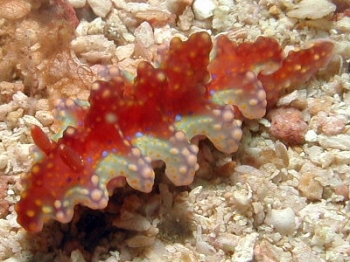
Concerning message #19854:
Dear Bill,
Here is a shot of a Ceratosoma sinuata / C. flavicostata ...
it fits somehow both descriptions: the long central lobe at the head makes it C. sinuata, the whitish mantle margin and red colour makes it C. flavicostata.
Locality: Gato Nudibranch City, Malapascua Is., 12 m, Philippines, Pacific Ocean, 11 Oct. 2003. Length: 31 mm. Photographer: Erwin Koehler.
So, what is it?
Regards Erwin
Erwin@Philippine-Sea-Slugs.com
Koehler, E., 2007 (Jun 19) Ceratosoma sinuata or what?. [Message in] Sea Slug Forum. Australian Museum, Sydney. Available from http://www.seaslugforum.net/find/19998Dear Erwin,
This is precisely the reason I left them all as 'one species' for 10 years [message #19853]. While there are extremes which fit the various names very well, there seem to be a lot of intermediates.
If there is more than one species I suspect this is C. magnifica. If this is the case, then this species is not restricted to the western Indian Ocean.
Best wishes,
Bill Rudman
Re: Is Ceratosoma magnifica a good species ?
June 19, 2007
From: Erwin Koehler
Concerning message #19854:
How about Ceratosoma sinuata on Jun Imamoto's site?
Regards
Erwin
Erwin@Philippine-Sea-Slugs.com
Koehler, E., 2007 (Jun 19) Re: Is Ceratosoma magnifica a good species ?. [Message in] Sea Slug Forum. Australian Museum, Sydney. Available from http://www.seaslugforum.net/find/20003Dear Erwin,
I think that like other species of Ceratosoma, actual colours - as distinct from colour patterns - may not be as important as it is in other genera of the chromodorids. The animal in Jun Imamoto's photo has a background green colour which suggests C. sinuata, but the shape and colour of the yellow marks, blue marks, rhinophores and gills are all identical to 'typical' C. flavicostata, and I would be quite comfortable identifying it as C. flavicostata. My interpretation is that in this case the background colour is green not reddish.
Of course I could be quite wrong, but now that I have suggested a pattern, this is a good way to test it. At least for a while I think we should look at general body and colour pattern and ignore, or at least downgrade, the background colour.
Good luck,
Bill Rudman
Mantle glands in Ceratosoma magnifica? from the Red Sea
May 8, 2007
From: Bill Rudman
In Binyamin Koretz's message [#19871] about Ceratosoma magnifica I meant to draw attention to the mantle glands which can be seen as small whitish swellings around the tips of the lateral lobes at the mantle edge. It is quite difficult to see the mantle glands in some species of Ceratosoma, and in this species they seem to be concentrated at least in the tips of these lateral 'lobes' along the mantle edge. I suspect they are probably in the median horns as well. While the more 'typically' shaped species such as C. trilobatum, C. gracillimum and C. tenue, concentrate the glands - and the antifeedant sponge metabolites they contain - in their single postero-dorsal horn, the species with lateral lobes appear to concentrate glands in those as well. A good intermediate is Ceratosoma moloch which has a posterior horn and gland-filled lateral lobes [Rudman, 1988].
-
Rudman,WB (1988) The Chromodorididae (Opisthobranchia: Mollusca) of the Indo-West Pacific: the genus Ceratosoma J.E. Gray. Zoological Journal of the Linnean Society, 93(2), 133-185.
Bill Rudman
Rudman, W.B., 2007 (May 8) Mantle glands in Ceratosoma magnifica? from the Red Sea. [Message in] Sea Slug Forum. Australian Museum, Sydney. Available from http://www.seaslugforum.net/find/19893Re: Ceratosoma magnifica? from the Red Sea
May 7, 2007
From: Binyamin Koretz
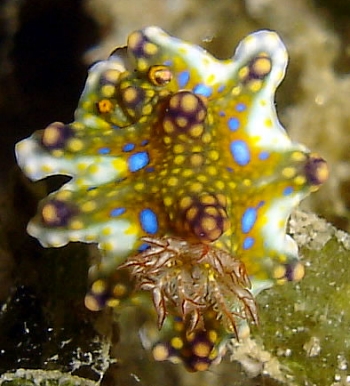
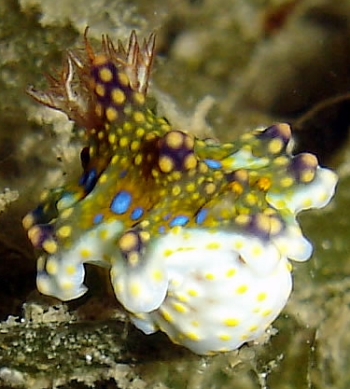
Concerning message #19854:
Hi Bill,
This little slug looks something like Oren's animal but green, and with a couple of the dorsal tubercles forming prominent 'horns' like in Eliot's drawing. Unfortunately the rhinophores were withdrawn when we photographed it, but the gills are red-edged, which might fit into your "Red Sea possibly Ceratosoma magnifica " category.
Locality: Eilat, Satil Area, 24m, Israel, Red Sea (Gulf of Eilat), 7 Jun 2006 (night), grassy expanse (with occasional corals) at foot of slope. Length: 12 mm. Photographer: Binyamin and Shulamit Koretz.
Best regards
Binyamin
binyamin@koretz.net
Koretz, B., 2007 (May 7) Re: Ceratosoma magnifica? from the Red Sea. [Message in] Sea Slug Forum. Australian Museum, Sydney. Available from http://www.seaslugforum.net/find/19871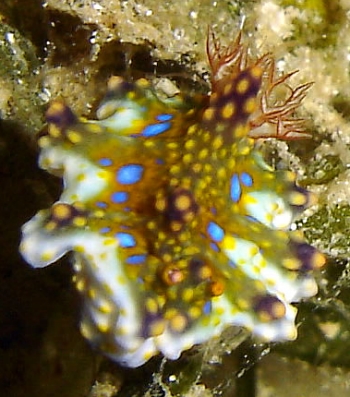
Dear Binyamin,
It certainly does fit Eliot's animal very well. In the original painting the traces of purple seem to be restricted to the dorsal horns and the rounded projections of the mantle edge, which is exactly where the purple is in your animal.
Best wishes,
Bill Rudman
Ceratosoma magnifica? from the Red Sea
April 30, 2007
From: Oren Lederman
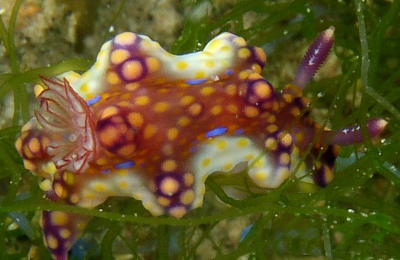

Hi Bill,
We couldn't identify these animals. The upper photo is of a different animal than the lower one.
Locality: "The princess beach", Eilat Bay, Depth: ~25 meters, Israel, Red Sea. Length: ~3-4 cm. 18 Feb 2005. Photographer: Oren Lederman
Oren Lederman
lederman@bigmail.co.il
Lederman, O., 2007 (Apr 30) Ceratosoma magnifica? from the Red Sea. [Message in] Sea Slug Forum. Australian Museum, Sydney. Available from http://www.seaslugforum.net/find/13210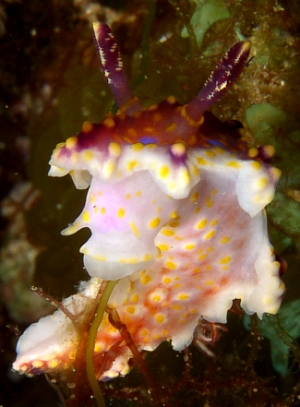
Dear Oren,
Your message has taken a while to see the light of day but at least I can say something sensible about it now. I think it may be Eliot's Ceratosoma magnifica. Have a look at the separate message where I discuss this group of species, which used to be 'Miamira' [message #19854]
Note in particular how the yellow spots oon the rhinophores are arranged in vertical lines, and that the gills are edged in red
Best wishes,
Bill Rudman
Is Ceratosoma magnifica (Eliot, 1910) a good species?
April 30, 2007
From: Bill Rudman

There has been a history of confusion surrounding the genera Miamira Bergh, 1875, Orodoris Bergh, 1875, Fracassa Bergh, 1878 and their included species. Some of the history of this is outlined in Valdes & Gosliner (1999) who proposed that this group are species of the chromodorid genus Ceratosoma. In their study they examined Ceratosoma miamirana [= Orodoris miamirana Bergh, 1875; Fracassa tuberculosa Eliot, 1903] and Ceratosoma sinuata [= Doris sinuata van Hasselt, 1824; Miamira nobilis Bergh, 1875].
PAINTINGS: Miamira magnifica: original illustrations from Eliot, 1910: Pl. 25.
Unfortunately they did not examine specimens of two other putative species, Miamira magnifica Eliot, 1910 and Miamira flavicostata Baba, 1940. Following Baba & Hamatani (1974), I have until now on the Forum considered all the various coloured forms of 'Miamira' to be part of one variable species [see message #19853] but the persistent use of the name 'Miamira magnifica' and 'Ceratosoma magnifica' in colour picture books is causing widespread confusion.
There is now a considerable number of records of the 'Miamira' group on the Forum and from those we can see there are two main groups. In one of these the background colour of the animals ranges from bright green to dull purplish brown and the whole body is covered with low rounded yellowish tubercles. Both the gills and the rhinophores are translucent greenish or brownish - depending on the background colour - and have scattered white spots. The anterior end of the mantle is trilobed with the central lobe being much longer than the other two. This colour form fits the original description of Ceratosoma sinuata very well and there can be no doubt of its identity.
The second colour form usually has a broad whitish margin to the mantle, the rest of the mantle being a reddish brown to bright purple with orange rounded ridges. The rhinophores usually lack white markings, but the gills are edged with opaque white lines. The front of the mantle does not have a prominent central lobe. This colour form fits the original description of Miamira flavicostata Baba, 1940. In many popular photo books the name Miamira magnifica or Ceratosoma magnifica is used for this purplish species.
What is Miamira magnifica Eliot, 1910? Unfortunately, like so many early descriptions it was based on a single preserved specimen. It was trawled off the Seychelles, and as Eliot notes 'this description was taken from the preserved animal some time after the colour drawing was made'. In the description he mentions greens and purples and white spots, but we have no idea whether these colours represent the live animal or are the result of the real pigments reacting to preservatives. If the greens are real colours then this would have to be C. sinuata because C. flavicostata does not have green coloration, but from the original drawings we can see that the mantle has a pattern of rounded tubercles and some short ridges. Eliot does note that the oral tube is a 'beautiful purple colour' and the rachis of the gills is a yellowish white, making 'a vivid contrast of colours' which may suggest C. flavicostata but we have little to go on.
Some authors have compared the number of radular teeth with animal length but these seem to have all been done with preserved animals. As specimens can shrink to half their living length in preservative, such comparisons based on so few specimens, seems valueless at present. Consideration has also been given to the size and number of the medio-dorsal mantle tubercles, but again these appear to be variable, some specimens having very low bumps and others very prominent erect horns.
From the available information it would seem there are at least two species in this group, one with rounded tubercles and white spots on the gills and rhinophores which we can identify with C. sinuata, and another species with a ridged pattern and distinctive white lines on the gills which can be identified as Baba's M. flavicostata - more appropriately known as Ceratosoma flavicostata. Eliot's description fits neither of these species well.
Is it possible that Eliot's M. magnifica is a third species? At present we have no record of a living 'flavicostata'- like animal from the western Indian Ocean, where M. magnifica was found. However there are three records on the Forum of 'sinuata'-like animals with yellow lines on the rhinophore clubs, one from South Africa [#2147] with white edged gills and two from the Red Sea [#13210, #6822] with red edged gills. Perhaps this is Eliot's species? At present I am recognising C. sinuata and C. flavicostata, because they are identifiable, and tentatively recognising C. magnifica for the few anomolous western Indian Ocean animals I mention above.
-
Baba, K. (1940) Miamira flavicostata n.sp., a nudibranchiate mollusc from Amakusa, Japan. Zoological Magazine, Japan 52(6), 239-240.
-
Baba, K & Hamatani, I. (1974) On the synonymy of Miamira sinuata (van Hasselt, 1824) from Japan (Nudibranchia: Dorididae: Miamirinae). Venus, The Japanese Journal of Malacology 33 (2, August), 81-84.
-
Eliot, C.N.E. (1910) Nudibranchs collected by Mr. Stanley Gardiner from the Indian Ocean in H.M.S. Sealark. Reports of the Percy Salden Trust Expedition to the Indian Ocean in 1905, under the leadership of Mr. J. Stanley Gardiner, M.A. Transactions of the Linnean Society, Zoology, series 2, 13(2), 411-439, Pl. 25.
-
Valdes, A. & Gosliner, T. (1999) Reassessment of the systematic status of Miamira Bergh, 1875 and Orodoris Bergh, 1875 (Nudibranchia; Chromodorididae) in light of phylogenetic analysis. Journal of Molluscan Studies, 65:33-45.
Bill Rudman
Rudman, W.B., 2007 (Apr 30) Is Ceratosoma magnifica (Eliot, 1910) a good species?. [Message in] Sea Slug Forum. Australian Museum, Sydney. Available from http://www.seaslugforum.net/find/19854Ceratosoma sinuata from the Red Sea
May 6, 2002
From: Dr. Jacob Dafni
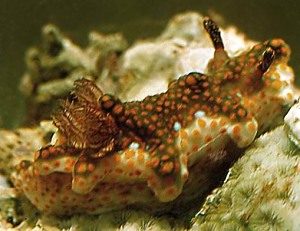
Dear Bill,
Enclosed is another unknown nudibranch, found several years ago at Eilat, Red Sea.
I could not find any hint in your gallery. Hope it is something new.
Dr. J. Dafni
jdafni@netvision.net.il
Dafni, J., 2002 (May 6) Ceratosoma sinuata from the Red Sea. [Message in] Sea Slug Forum. Australian Museum, Sydney. Available from http://www.seaslugforum.net/find/6822Note added 30 April 2007: Until now on the Forum C. sinuata and C. flavicostata have been considered forms of one species. See message #19854 where they and C. magnifica are considered separate species.
Dear Jacob,
I am pretty sure that this is the green and yellow-spotted form ofCeratosoma sinuata. I have some difficulty in accepting all these colour forms are the same species, but our state of knowledge at the moment suggests they are.
Best wishes,
Bill Rudman
Miamira magnifica? from South Africa
March 27, 2000
From: Valda Fraser
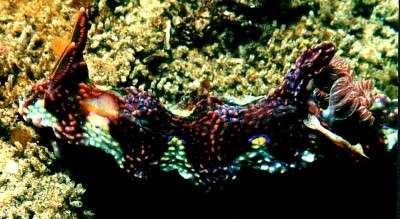
Dear Bill
Unfortunately a poor photo! It seems that the family Miamiridae is problematic. Is this specimen Miamira magnifica?
Do shrimps commonly live on this species?
Thanks for the help.
Locality: South coast KwaZulu-Natal SOUTH AFRICA. near Port Shepstone - 18m
Date: April 1999
Size: 50mm
Regards
Valda Fraser
iti04937@mweb.co.za
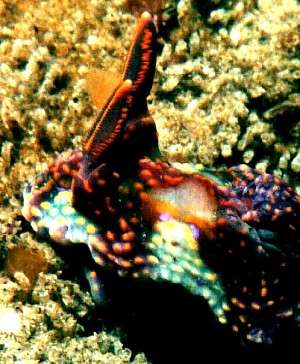

Note added 30 April 2007: Until now on the Forum C. sinuata and C. flavicostata have been considered forms of one species. See message #19854 where they and C. magnifica are considered separate species.
Dear Valda,
I'm not quite sure where we draw the line with this 'species'. At present I am putting all the colours together asCeratosoma sinuata. I have included close-ups of the head and gill regions to show the colour better. I assume the object I have arrowed is the shrimp you ask about. I assume it is Periclimenes imperator which although notmally associated with Hexabranchus sanguineus, seems to live in association with lots of larger opisthobranchs
Best wishes,
Bill Rudman.
